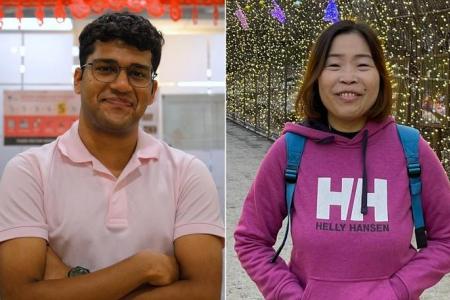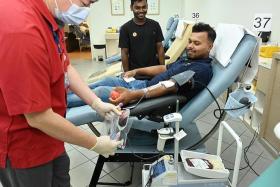More youth blood donors needed for Singapore’s ageing population
Every blood donation can save three lives.
This is the motivation for National University of Singapore undergraduate Shiek Abdullah Mohamed Fazil, 23, who has donated blood 13 times since 2019.
“It’s a personal satisfaction knowing that each blood donation can save three people, even though I don’t know who the blood goes to,” he said.
Mr Fazil, whose blood type is O, started donating at age 18 when he joined the Red Cross Youth Chapter in Ngee Ann Polytechnic. He also helped the polytechnic organise blood donation drives.
Unlike him, many of his peers are not donating blood.
“Some are scared of the needle,” he said. “We need to inspire generations of blood donors by starting them young, such as through correcting misconceptions and developing their interest in schools.”
The Singapore Red Cross (SRC) and the Health Sciences Authority (HSA) told The Straits Times that the number of youth blood donors aged 16 to 25 continued its downward trend in 2023.
Youth accounted for 15 per cent of the total donor pool in 2023, compared with 17 per cent in 2022. In 2021, they constituted 20 per cent of all donors. More than a decade ago, in 2011, youth accounted for 33 per cent.
The downward trend comes even as the total number of blood donors has inched up slightly.
In 2023, there was a total of 77,424 blood donors, who made up 1.87 per cent of Singapore’s total population.
This was slightly higher than in 2022, when there were 74,154 blood donors, or 1.82 per cent of the total population. In 2021, there were 69,032 blood donors, or 1.73 per cent of the population.
SRC said the decrease in youth blood donors worsened during the pandemic, when it cancelled its school outreach and mobile blood drives. These are important avenues for youth donors to learn about blood donation and start their donation journey.
“While we have resumed these activities, it takes time and effort to build up the momentum and grow the pool of youth blood donors again,” said SRC’s spokesperson.
SRC works with youth organisations, including schools and institutions of higher learning, to promote and educate youth on the importance of blood donation, and to dispel misconceptions such as blood donation being painful and that donors can catch diseases.
There are also ground-up efforts to empower youth to run public donation drives and organise group donations at the blood banks to encourage peer-to-peer donor recruitment.
The Singapore Red Cross Youth, a co-curricular activity in schools, recently announced the Youth Blood Donor Programme. It aims to develop blood donation ambassadors and activists, who will reach out to their peers and family members.
SRC also launched a Youthphoria award on World Blood Donor Day in October 2023 to inspire more young people to donate blood regularly. In addition, it rolled out digital initiatives like the DonateBlood app, a Facebook blood donation tool and the Blood Buddy Instagram to reach a more tech-savvy audience and engage the next generation of donors.
With about 600 donors stopping donations due to age or illnesses each year, it is crucial to constantly increase Singapore’s pool of blood donors.
“We need more youth donors to start donating now, and to make it a lifelong habit,” said HSA’s spokesperson. “This will ensure the sustainability of our blood supply into the future.”
In 2023, more than 114,000 units of blood were transfused. To meet Singapore’s blood demand, about 125,000 units of blood have to be collected annually.
This will increase to more than 160,000 units a year by 2030 due to a super-aged population and increased healthcare needs.
As people age, they are more prone to developing multiple medical conditions, which can increase their susceptibility to anaemia and the need for blood transfusions. HSA said those aged 60 years and above make up 20 per cent of Singapore’s population but accounted for 60 per cent of total red blood cell usage.
On Jan 25, SRC and HSA issued an appeal for people with O blood type to donate blood during the period leading up to the Chinese New Year (CNY) holiday. Stocks of this blood type are currently at critical levels due to high usage and lower-than-normal donor turnout since the start of 2024.
During festive seasons such as CNY, blood collection can dip by as much as 20 per cent.
As the universal blood group, O blood type is required during emergencies when patients’ blood groups are unknown.
Nearly half of all patients in Singapore have O blood type, and can receive only a similar blood type. If group O blood stocks continue to drop, elective surgery will have to be postponed and life-saving transfusions could also be compromised.
Ms Kymn Yee, a 44-year-old lecturer who was diagnosed with thalassaemia when she was a few months old, receives a blood transfusion once every three weeks at the National University Hospital. Each session takes about nine hours, including waiting time.
“There had been occasions in the past when I was told that there was insufficient blood in the blood bank for me, so I had to go home without blood,” she said. “This was really frustrating as it meant I had to go back the following weekend.”
The situation is better now, though there are still times when she would get just one or two packets of blood due to supply shortage.
She needs three packets of blood for her haemoglobin level to be normal. “I will feel faint, tired and lethargic, and arrangements will have to be made for me to go another day to get the required amount of blood,” said Ms Yee, who is an avid scuba diver and a yoga practitioner.
For more information on blood donation, go to the SRC website giveblood.sg
Get The New Paper on your phone with the free TNP app. Download from the Apple App Store or Google Play Store now


